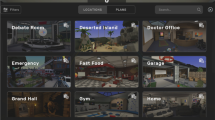Abstract
The study considers the problems relating to vocational training of specialists in the virtual educational environment of a higher education institution. The use of advanced information and communication systems (electronic mail, electronic teleconferences, electronic and information resources including text, visual, audio and video information) and virtual technology (Daydream, Vive VR, technology of virtual games) in the educational process of a higher education institution enables to realize an interactive communication of the participants of this process. The article presents the experience on introduction of the virtual educational environment using LMS Moodle, and the authors consider the influence of such environment on the interactive engagement of the students and teachers from the universities in Kazakhstan and Slovakia. We have tried to demonstrate how the LMS Moodle platform helps arrange e-learning, conduct lessons in electronic classrooms, take online courses, and conduct synchronous and asynchronous learning. The developed online tasks allowed for the monitoring of the students’ progress in all the educational activities. The results of the experiment helped guide the choice of follow-up study in this area.











Similar content being viewed by others
References
Achuthan, K., Kolil, V. K., & Diwakar, S. (2018). Using virtual laboratories in chemistry classrooms as interactive tools towards modifying alternate conceptions in molecular symmetry. Education and Information Technologies, 23, 2499–2515. https://doi.org/10.1007/s10639-018-9727-1.
Al-Busaidi, K. A., & Al-Shihi, H. (2012). Key factors to instructors’ satisfaction of learning management systems in blended learning. Journal of Computing in Higher Education, 24, 18–39. https://doi.org/10.1007/s12528-011-9051-x.
Blanco, M., & Ginovart, M. (2012). On how Moodle quizzes can contribute to the formative e-assessment of first-year engineering students in mathematics courses. Revista de Universidad y Sociedad del Conocimiento, 9, 354. https://doi.org/10.7238/rusc.v9i1.1277.
Bogdanov, E., Ullrich, C., Isaksson, E., Palmér, M., & Gillet, D. (2012, September). From LMS to PLE: A step forward through opensocial apps in moodle. International Conference on Web-Based Learning, 69–78. https://doi.org/10.1007/978-3-642-33642-3_8.
Borba, M. C., Chiari, A. S., & de Almeida, H. R. F. L. (2018). Interactions in virtual learning environments: New roles for digital technology. Educational Studies in Mathematics, 98, 269–286. https://doi.org/10.1007/s10649-018-9812-9.
Echeverria, L., Cobos, R., & Morales, M. (2013). Designing and evaluating collaborative learning scenarios in Moodle LMS courses. In International Conference on Cooperative Design, Visualization and Engineering (pp. 61–66). Berlin, Heidelberg: Springer.
El Mawas, N., Oubahssi, L., & Laforcade, P. (2016). A method for making explicit LMS instructional design languages. Technology, Instruction, Cognition & Learning, 10(3).
Genci, J. (2013). Methods to ensure higher variability of knowledge tests in the moodle LMS environment. Emerging Trends in Computing, Informatics, Systems Sciences, and Engineering, 447–453.
Herrador-Alcaide, T.C., Hernández-Solís, M. & Sanguino Galván, R. (2019) Feelings of satisfaction in mature students of financial accounting in a virtual learning environment: an experience of measurement in higher education International Journal of Educational Technology in Higher Education 16: 20. https://doi.org/10.1186/s41239-019-0148-z, Feelings of satisfaction in mature students of financial accounting in a virtual learning environment: an experience of measurement in higher education, 19.
Kerimbayev, N. (2019). Formats of virtual learning. In A. Tatnall (Ed.), Encyclopedia of education and information technologies. Cham , Formation Technologies: Springer. https://doi.org/10.1007/978-3-319-60013-0_201-1.
Kerimbayev, N., Akramova, A., & Suleimenova, J. (2016). E-learning for ungraded schools of Kazakhstan: Experience, implementation, and innovation. Education and Information Technologies, 21(2), 443–451. https://doi.org/10.1007/s10639-014-9331-y.
Kerimbayev, N., Kultan, J., Abdykarimova, S., & Akramova, A. (2017). LMS Moodle: Distance international education in cooperation of higher education institutions of different countries. Education and Information Technologies, 22(5), 2125–2139. https://doi.org/10.1007/s10639-016-9534-5.
Konstantinidis, A., Tsiatsos, T., & Pomportsis, A. (2009). Collaborative virtual learning environments: Design and evaluation. Multimedia Tools and Applications, 44, 279–304. https://doi.org/10.1007/s11042-009-0289-5.
Lyashenko, M. S., & Frolova, N. H. (2014). LMS projects: A platform for intergenerational e-learning collaboration. Education and Information Technologies, 19(3), 495–513. https://doi.org/10.1007/s10639-014-9333-9.
Mavengere, N., & Ruohonen, M. (2018). Context and user needs in virtual learning in pursuit of qualities of learning. Education and Information Technologies, 23, 1607–1620. https://doi.org/10.1007/s10639-017-9681-3.
Mpungose, C. B. (2019). Is Moodle or WhatsApp the preferred e-learning platform at a South African university? First-year students’ experiences. Education and information technologies, 1–15. https://doi.org/10.1007/s10639-019-10005-5.
Nurakun Kyzy, Z., Ismailova, R., & Dündar, H. (2018). Learning management system implementation: A case study in the Kyrgyz Republic. Interactive Learning Environments, 26(8), 1010–1022.
Oh, E. G., Huang, W. H. D., Mehdiabadi, A. H., & Ju, B. (2018). Facilitating critical thinking in asynchronous online discussion: Comparison between peer-and instructor-redirection. Journal of Computing in Higher Education, 30(3), 489–509. https://doi.org/10.1007/s12528-018-9180-6.
Shang, H. F. (2017). An exploration of asynchronous and synchronous feedback modes in EFL writing. Journal of Computing in Higher Education, 29(3), 496–513. https://doi.org/10.1007/s12528-017-9154-0.
Stahre Wästberg, B., Eriksson, T., Karlsson, G., Sunnerstam, M., Axelsson, M., & Billger, M. (2019). Design considerations for virtual laboratories: A comparative study of two virtual laboratories for learning about gas solubility and colour appearance. Education and Information Technologies, 24, 2059–2080. https://doi.org/10.1007/s10639-018-09857-0.
Author information
Authors and Affiliations
Corresponding author
Additional information
Publisher’s note
Springer Nature remains neutral with regard to jurisdictional claims in published maps and institutional affiliations.
Rights and permissions
About this article
Cite this article
Kerimbayev, N., Nurym, N., Akramova, А. et al. Virtual educational environment: interactive communication using LMS Moodle. Educ Inf Technol 25, 1965–1982 (2020). https://doi.org/10.1007/s10639-019-10067-5
Received:
Accepted:
Published:
Issue Date:
DOI: https://doi.org/10.1007/s10639-019-10067-5




